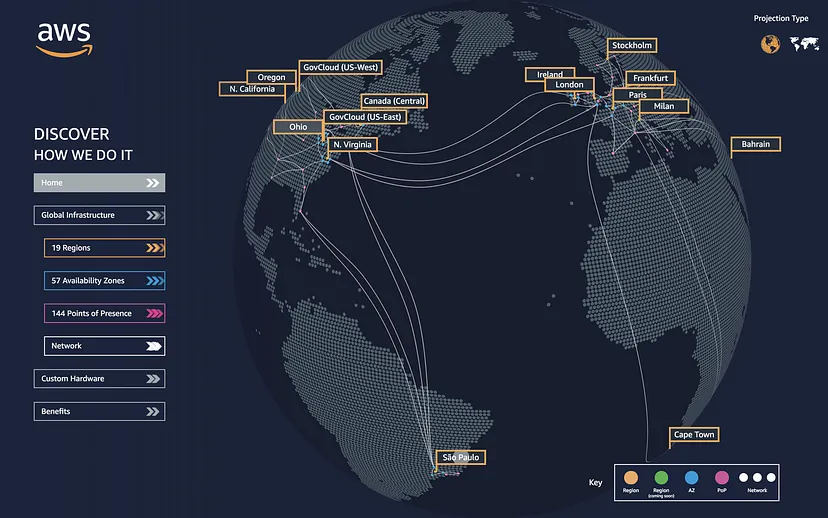AWS Global Infrastructure - Optimizing Resource Deployment Across Regions
A fundamental aspect of leveraging AWS’s capabilities lies in understanding its global infrastructure. AWS’s physical data centers are structured in a way that enables high availability, reliability, and scalability for services across the globe. This blog post will delve into the AWS Global Infrastructure, focusing on how Availability Zones and AWS Regions work together to provide a secure and efficient platform for your cloud workloads. Understanding these concepts can help you make informed decisions about resource deployment, optimize user experience, and control costs. We will explore key factors to consider, such as compliance, performance, and cost, all while adopting a DevOps-centric perspective.
AWS Regions and Availability Zones
Understanding AWS Regions and Availability Zones
The AWS Global Infrastructure is built around two key concepts: Availability Zones and AWS Regions. Availability Zones are logical groupings of one or more physical data centers. Each AWS Region, in turn, consists of multiple Availability Zones that are physically separated and isolated from each other, providing redundancy and fault tolerance.
- Each AWS Region is designed to be geographically isolated, ensuring that an issue in one region does not affect others. Within each region, Availability Zones are connected using dedicated, low-latency networks, which makes them suitable for high availability setups. For instance, deploying a multi-AZ architecture for a database service ensures that even if one data center experiences issues, the other zones can maintain service continuity.
- As a best practice, DevOps teams can leverage these logical separations to increase resilience. For example, critical applications can be deployed across multiple Availability Zones to provide failover capabilities. This means that in the event of a failure in one data center, applications remain operational through redundancy.
Choosing the Right AWS Region
Factors to Consider When Selecting an AWS Region
Selecting the appropriate AWS Region for hosting your services is a critical decision that impacts performance, compliance, and cost. Let’s look at the major factors to consider:
- User Location is a primary consideration when selecting an AWS Region. Deploying resources close to the majority of your end users minimizes latency, improving user experience. For instance, if most of your users are located in South America, choosing the São Paulo AWS Region would reduce latency compared to using the Singapore AWS Region. This is crucial for performance-sensitive applications.
Compliance and Data Residency requirements can also dictate the choice of region. Certain regulations require data to be stored within specific geographical boundaries. For instance, healthcare applications may need to ensure data residency within a particular country to comply with local laws, such as GDPR in Europe.
Service Availability: Not all AWS services are available in every region. It’s important to review the service offerings of the selected region to ensure it supports your current and future project needs. This proactive approach avoids situations where expanding to a new service requires switching regions later.
- Cost Considerations: Cost is another factor, as it varies across regions due to local regulations and operating expenses, such as electricity. Identifying the optimal balance between latency, compliance, and cost is a strategic move for long-term savings. For example, while regions like US East (N. Virginia) might have lower operational costs, other factors like compliance or user location may influence the decision.
AWS Global Infrastructure Pricing
Optimizing Resource Deployment for High Availability
Strategies for High Availability and Resilience
High availability is a cornerstone of cloud architecture. AWS Regions and Availability Zones provide a robust foundation for building fault-tolerant applications.
- DevOps teams should adopt multi-AZ deployments to ensure high availability. For example, deploying an Amazon RDS instance across multiple Availability Zones ensures that even if one zone goes offline, the database remains available through an automatic failover mechanism.
- Applications that require global resilience can be deployed across multiple AWS Regions. This approach is particularly useful for disaster recovery planning, allowing the workload to fail over to another region in the event of a catastrophic failure. Services like AWS Route 53 can be used to direct traffic intelligently between these regions, ensuring minimal downtime.
Cost and Performance Trade-offs
Deploying across multiple regions and availability zones provides significant benefits but also requires careful management of costs and performance.
- While multi-region deployments enhance resilience, they come with increased data transfer costs and latency challenges. It is essential to evaluate these trade-offs to determine whether the added resilience justifies the cost. For many critical applications, the additional investment in cross-region redundancy can prevent costly downtime.
- Leveraging Auto Scaling and Elastic Load Balancing within a region can help balance performance and cost. By automatically adjusting resource allocation based on demand, these services help maintain performance during peak periods without the need for constant over-provisioning.
AWS Multi-Region Deployment Strategies
AWS’s Global Infrastructure, comprised of strategically placed Regions and Availability Zones, provides a powerful foundation for building resilient, scalable, and high-performing applications. As a DevOps engineer or programmer, understanding how to effectively leverage these resources is essential to creating cloud solutions that meet both business and technical requirements. Whether it’s ensuring compliance, optimizing for user experience, or balancing cost and availability, the choice of AWS Region and the deployment strategy you implement can significantly impact your application’s success.
Embrace AWS’s global reach and resilient architecture to craft solutions that stand up to the demands of a modern, distributed user base. Take advantage of AWS’s features to optimize performance, comply with regulations, and maintain cost efficiency for your cloud infrastructure.
For more in-depth information on AWS Regions, Availability Zones, and best practices, consider exploring AWS Global Infrastructure and the AWS Well-Architected Framework. These resources offer additional insights into building effective, scalable, and secure cloud environments.
